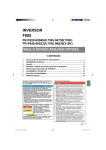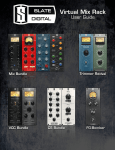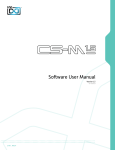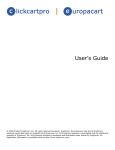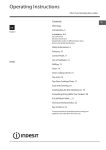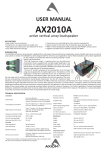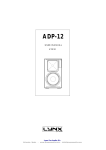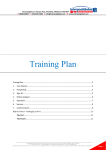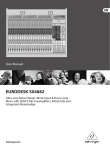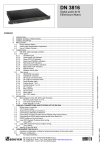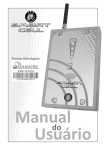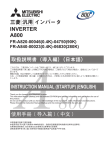Download EDB-2 Manual - Headway Music Audio
Transcript
Sheer Acoustic Equaliser Direct Blend: EDB-2 Multi-function Pre-amplifier with EQ, Blend & Direct Injection functions for superior Acoustic Amplification. Designed in UK INSTRUCTION MANUAL EDB-2 provides a beautifully voiced and practical solution to the diverse and critical needs for high quality acoustic musical instrument amplification. Suitable for stage and other signal processing. EDB-2 offers an increased range of gain to interface better with Mixers, luxurious amounts of EQ and other highly versatile facilities to get the best possible sound from amplified acoustic stringed instruments. Now offering reduced noise levels! 1 From a single compact box, the EDB-2 can take on a unique range of functions and qualities which include: • Refined Class "A" inputs and Pro Audio IC components. • Voiced for warmth, clarity & low noise Now offering increased clarity and even lower noise. • Effective 5 Band EQ for problem solving and creativity. Now offering EQ on Ch.1, Ch.2 or on both Channels. • Easily read Pro Audio design panel layout. Now offering a HUGE 0 - 32dB Gain! • Versatile inputs, switchable to optimise a comprehensive range of passive and active pickups, plus Microphones. Now offering 3 way Impedance switching on Ch.2 •Tuneable notch filter with switch for extended range of attack on feedback and problem frequencies. Now offering notch filter on Ch. 1 or Ch.2. • Range switch with settings for Guitar, Bass and Violin. Removes unwanted boom, handling noise and low frequency feedback to amplify a clearer, more musical tone of the instrument. • Signal splitting enabled, e.g. personal/stage monitoring plus to front of house, recording or tuner. • Dual system mixing of pickups and Mics via separate channels with differing EQ’s. • Phantom Powering of all suitably wired Pickup and Mic Systems via Ch.1 Jack IN Now Offering Phantom to “Ring” or “Tip”. • Mic XLR Input offers 18v Phantom to Power 99% of Condenser Mics. 2 • Feedback and hum loop busted via Earth lift and Phase Reverse switches,. Now offering Phase Reverse on Ch.1 or Ch.2 • New Aux IN Mini-Jack to allow iPod Connection. • Mounting via rubber feet, belt clip (included) or on Mic Stand. • Extended headroom via 18v power supply. • Powered via regulated mains power supply unit (PSU - included) or 9v PP3 (6F22 batteries – 2 included). • Sturdy steel housing with quality pots and long life sockets. • Choice of input and output connectors. Congratulations on your astute purchase. Please read this comprehensive manual carefully before switching on or plugging in the EDB-2 Text is also available on website below: www.headwaymusicaudio.com Headway Quality! Built to last & Guaranteed for 12 Months. 3 HEADWAY EDB‐2 Top Panel POWER ON/OFF/STANDBY Green LED Indicates Power Pause in Standby Posi on to Reduce Power on “Thump” LOW BATTERY LED Lights BLUE when Ba eries are within hours of expiring EARTH/GROUND LIFT Prevents Hum Loop by Disconnec ng Pin 1 from XLR OUT MASTER Sets Output Level to LINE OUT & XLR Out NOTCH FILTER ‐12dB Notch Q=Band width Freq. = Centre Frequency of cut. Switches : CH.1 CH.2 or OFF MUTE Turns OFF Output Signals Re. Red LED. LIVE Denotes Pre‐Amp Output ON 5 BAND EQ SWITCH Assigns 5 Band EQ to CH.1 or CH.2 or BOTH 5 BAND EQ Treble @ 10 kHz +/‐ 13dB Pres @ 2.8 kHz +/‐ 7dB H.Mid @ 880 Hz +/‐ 12dB L.Mid @ 590 Hz +/‐ 13dB Bass @ 120 Hz +/‐ 12dB As Above @ 45Hz +/‐ 16dB XLR SWITCH/MIC IN 18v Phantom ON Phantom OFF XLR OFF RANGE FILTER (High Pass Filter) VIOLIN @ 192 Hz GUITAR @ 85 Hz BASS @ 41 Hz INPUT GAIN 0dB‐+32dB CH.1 & CH.2 INPUT IMPEDANCE +HI & HI ‐ Passive Pickups. Ac ve/LOW ‐ Powered or Low Impedance Pickups Switches: CH.1 & CH.2 PHASE Reverse the Phase of CH.1 or CH.2 Signal. An ‐Feedback Op on 4 EDB‐2 RH Side Panel AUX IN/iPOD INPUT 3.5mm Mini Jack Post EQ to Master Vol. EDB‐2 Front Panel CH.1 JACK IN Mono IN (Refer to Input Impedance Switch & Phantom Power Switch) PHANTOM POWER TO CH. 1 JACK IN SWITCH DI/XLR LINE OUT Balanced Line Output XLR (Mono Mix) *This does NOT accept Phantom Power From Mixer* LINE OUT Low Impedance Mono Mix Jack Out OPTIONS Belt Clip (as shown) or Mic Stand Adaptor 19/32” (15mm) CH.2 MONO JACK IN Routes Stereo to Both Channels if No Jack in CH.1 EDB‐2 Rear Panel EXT. POWER IN 18v AC/DC Adapter Input Connector Use ONLY Headway EDB‐PSU CH.2 MIC/XLR IN Balanced with 18v Phantom Power Op on. See XLR Switch: XLR Off/On Phantom On BATTERY PANEL (PP3/6F22 x 2) With Cap ve Screw 5 CONTENTS 1 SAFETY PRECAUTIONS & OPERATION 2 EDB-2 FEATURES, POWER ON & STANDBY 3 CHANNEL 1: 3.1.1 - 3.1.6 3.2 INTERACTIVE 5 BAND EQ SECTION 4 CHANNEL 2 4.1 INPUTS & LEVEL CONTROL 4.1.1 MIC INPUT XLR 4.1.2 STEREO JACK INPUT 4.1.3 PHANTOM POWER 9v 4.1.4 PHANTOM POWER 18v 4.1.5 GAIN CONTROL 5 MUTE/LIVE SWITCH 6 NOTCH FILTER CONTROLS 7 MASTER VOLUME CONTROL 8 RANGE CONTROL SWITCH 9 BATTERY POWERING 10 PHASE REVERSE 11 SPECIFICATIONS 12 TROUBLE-SHOOTER CHECKLIST 6 1 SAFETY PRECAUTIONS & OPERATION 1.1 Important Safeguards to your life and gear to note before using your EDB-2 Please read all warnings on Headway Sheer Acoustic EDB-2 Equaliser Direct Blend unit very carefully: IMPORTANT: Make sure that you power only by Headway's supplied Power Supply Unit: Headway EDB PSU or via 2 x PP3 (9v) batteries as included with this unit. (Suitable for EDB-1 & EDM-1) Mains Plug Connector Types available for EDB-2: UK = United Kingdom/Eire/Singapore (e.g. EDB PSU UK) EU = Europe (Continental Mainland) NA = North America/S. America/Japan AUS = Australasia/S. Africa 1.1.1 EARTH PROTECTION & GROUNDING To prevent electric shock ensure that any input/output cables from EDB-2 are connected to amplification or signal processing devices (e.g. mixers, amplifiers, effects units) so that where Mains powered devices are used, there is a continuous, unbroken chain of Mains earth connection and where the mains supply at the venue offers a viable Earth or Ground connection. DO NOT disconnect the ground/earth wire on any connected mains powered devices. 1.1.2 MAINS PROTECTION Always take care to protect your own life and those of others, along with your gear by using RCD Circuit Breakers and AC Mains Surge Protectors at each source of the mains power. Circuit breakers should be tested prior to use. We recommend that you also use Mains Noise Filters. Switch off Power Supply Unit and other connected mains powered devices and unplug when EDB-2 unit is not in use. 7 1.1.3 SHOCKS WARNING Immediately stop the use of any Mains powered or Mains connected gear when even minor shocks are detected and seek a practical consultation from a qualified professional electronics repair technician or relevant approved Authorised Service Centre before using again. 1.1.4 PREVENTION OF SHOCKS & DAMAGE DO NOT expose the EDB-2, its Power Supply Unit or attached cables to any liquids such as rain, condensation/spilt drinks. If your EDB-2 should become in contact with any water or other liquids, switch off at mains power socket and disconnect. Make sure it is fully dry and dry your hands before re-use. 1.1.5 VENUE WARNING Avoid venues with suspect electrical wiring, damp or wet wires & contacts or where sparks are visible. 1.1.6 MICROPHONE SAFETY WARNING Where microphones are used into EDB-2 or PA system, try to use Government Type approved & Licensed Radio Mic’s and Transmitters. 1.1.7 CABLE & PRE-AMP PLACEMENT WARNING Place EDB-2 and cables where visible and cannot cause accidents, e.g. on a table, Mic stand or Belt mounting. DO NOT BLOCK EXITS! 1.1.8 PRECAUTIONS DURING USE Treat your EDB-2 with care and do not drop it, tread on it or subject it to liquids, extreme heat/cold or rough handling. Switch off power supply when EDB-2 is not in use for >1 hour. 1.1.9 MINIMISING PLUG IN AND SWITCH ON NOISE To minimise plug in noise connect cables in and out to instrument/Mic and to PA or amp etc. while EDB-2 is off or on Standby. Ensure that Standby has been engaged for at least 2 seconds before switching on. If requiring to change input cable while live, engage Mute or Standby first. Switchcraft, Neutrik, Deltron, ST Pro & GH Industries offer Jack Plugs for quieter switching. 8 1.2 SERVICING, REPAIR & RETURNS All Headway servicing and repairs should be carried out by Headway Music Audio Ltd. or its approved agents where applicable. All returns must be sent pre-paid and should be insured against loss. Headway Music Audio Ltd. will NOT be held responsible for losses in transit or for duty and taxes incurred, e.g. where customs documentation is completed incorrectly. Customs Declaration forms on returned products sent internationally should be completed and could read, for example: "Electrical Musical Instrument Amplifier unit returned to UK, country of landed origin for Service/Repair. Not for Re-sale. Value for Customs = $ 30.00 Customs Code: 8518.10.40 Unit will be returned to sender.” See: Transport 1.8 If returning product for repair/service you must include: Your full contact details including name, phone number, full mailing address and email address. A full description of any problems. If claiming under Guarantee/Warranty you must also include: Proof of Purchase clearly indicating date, business name and address of dealers who sold the product. DO NOT DISSEMBLE ANY PARTS OF YOUR EDB-2 since there are no user serviceable or repairable parts. Any attempt to do so would negate the guarantee. 1.3 CLEANING the EDB-2 Ensure that your EDB-2 Is UNPLUGGED before cleaning with a dry cloth. DO NOT allow moisture to enter amplifier and DO NOT use any chemically based or abrasive cleaning products. 9 1.4 PRODUCT LIABILITY Headway Music Audio Ltd. cannot be held responsible for damage to its products caused by the subjection to unreasonably high or low temperatures or due to wet conditions or for abuse/mishandling. Headway Music Audio Ltd. retains the right to make such determination according to its own inspection. 1.5 CONSEQUENTIAL LOSS Headway Music Audio Ltd. will not be responsible for consequential loss or damages such as due to the use or misuse of its products, accident, neglect, technical modifications or unreasonable expectations. Headway Music Audio Ltd. will not be held responsible for the application of Phantom Power from any of its products where some other electronic device may have been damaged. Headway Music Audio Ltd. retains the right to make all such determinations from its own inspection. 1.6 PERSONAL INJURIES Headway Music Audio Ltd. cannot be held responsible for personal injuries or damages related to its products such as those caused by heat, fire, obstruction, modifications or electrical shock where obtained due to a lack of care on the part of the injured party or due to that persons ignorance of the instruction manual or, due to that persons ignorance of best practices in the use of mains powered facilities. Headway Music Audio Ltd. retains the right to make any such determinations according to its own assessment. 1.7 WARRANTY/GUARANTEE TERMS EDB-2 guarantee is valid for up to, but no longer than 12 months from the date of purchase, but valid only after the guarantee registration has been made online at www.headwaymusicaudio.com All guarantee issues will be subject to assessment by Headway and appointed service agents where applicable. Headway Music Audio Ltd. does NOT recognise or participate within guarantees/warranties offered by third party companies such as retailers and dealers. 10 WHAT IS COVERED BY HEADWAY MUSIC AUDIO LTD. The labour and parts required for all functioning aspects of the amplifier. This guarantee is subject to: Full completion and receipt by Headway Music Audio Ltd. of online guarantee form within 30 days of purchase. Customers retention of proof of purchase indicating date, business name and address of dealers who sold the product. WHAT IS NOT COVERED Shipping related, handling or customs, tax & duty charges will NOT be covered under this guarantee. See 1.18 Physical damage and cosmetic blemishes. Electrical, electronic or audio problems will NOT be covered under this guarantee if caused by electronic or electrical misuse or general vandalism! This includes use of incorrect Power Supply. Damage caused by insufficient care in handling and/or inadequate transportation. Non–registered guarantees, partly completed registrations, expired guarantee periods or 3rd party issue guarantees will NOT qualify for free repair work or free transportation. WHAT IF I HAVE NOT REGISTERED THE GUARANTEE? If you have not registered the Guarantee/Warranty within 30 days of purchase you are not covered by the 12 Month Guarantee unless you are the end retail customer and have purchased direct from Headway Music Audio Ltd. If you have not registered it, you retain your statutory rights under consumer law of the country in which you purchased it from and your contract would be with the dealer/retailer or shop who sold you it. YOU CAN REGISTER IT IN ABOUT 1 MINUTE SO DO IT NOW BEFORE THE 30 DAY PERIOD EXPIRES! 1.8 STORAGE & TRANSPORT ADVICE Headway Music Audio Ltd. suggest storing & transporting the EDB-2 in the complete original box or inside a heavy cardboard box in good condition. Always pad it out in order to prevent the unit from shifting in transit. Due to previous “service issues” we suggest NOT using TNT, Yodel or Parcelforce. 11 International Shipping with Batteries: The following are banned from all normal International transit, loose or installed and may cause a return to sender: Lithium, Re-Chargeables or Used/Spent. 2 EDB-2 FEATURES, POWER ON & STANDBY QUIETER SWITCHING ON - Slide from Off slowly holding switch on Standby for 2 seconds, then switch ON. LED will glow green. 3 CHANNEL 1 3.1 INPUTS & LEVEL CONTROL 3.1.1 +HI IMP Ultra High Impedance Input: < 20 Meg Ohms This jack input is uniquely optimised for ultra high impedance passive, NON-Powered Pickups directly into EDB-2 The primary types of pickups include Piezo cable or Co-axial cable pickups (Headway HE4 Passive) or Flexible “Piezo Film” pickups as offered by a number of manufacturers. Most are flexible structure types but some film pickups are encased in rigid metal. Suitable cable should have at least 80% screening, preferably braided or conductive plastic shielding with extensive lapped screening. Metal jack covers should always be used with the cable as short as is possible, no more than 2m (6’) with standard quality cables (e.g. Klotz or Van Damme) or 3m (9’) with special low capacitance cable such as Sommer Cable. 3.1.2 HI IMP High Impedance Input: < 5 Meg Ohms This input is optimised for the commonly available passive under saddle Ceramic Piezo pickups or Contact/Bug pickups, also Headway's “The Band” (for bowed instruments). This input also gives a brighter sound for passive magnetic sound hole pickups. Lead lengths for the HI IMP input setting are best kept as short as is reasonably possible with good screening but no more than 6m (18') but this application is usually less critical than with +HI IMP pickups. 12 3.1.3 ACTIVE/LOW: Impedance Input < 50k Ohm This input is optimised for active pickup systems which require battery power. It is also used for some Passive Magnetic/Low Impedance pickups but on passives there will be a treble roll-off and hence a thicker more middle biased sound. Input leads carrying active signals are not so sensitive to shielding quality or cable length so leads up to 10m (33’) in length are fine. Also suits "Line Level". 3.1.4 STEREO JACK INPUT The general purpose stereo jack input feeds separate signals to both channels controlled by their two gain controls. The signal on the ring of the jack (usually a blue or black wire in cable) feeds channel 1. The signal on the tip of jack (usually a red or white wire in a stereo cable) feeds Channel 2. Check channel switching re. EQ & Notch Filter. 3.1.5 AUX IN/iPOD IN: Mini-Jack Socket The Mini-Jack Socket (3.5mm diameter) on side panel is intended mainly for connection of iPod for use of recorded music such as for backing music, interval music or for tuition purposes. It by-passes Gain & EQ and feeds into Master Volume Control. ACW = Backing a knob off or turning it Anti-Clockwise. CW = Turning a knob up or turning it Clockwise. 3.1.6 GAIN Knob: 0 -10 (0dB-32dB Gain) Turn CW to increase the gain on Channel 1 only. Each dot marker equals 2.5dB (approx) or +/- 40% GAIN & MASTER: Joint Operation. Method A. After plugging in at 0, turn Master up high then very gently turn gain control up CW slightly until you have reached the desired level for your instrument. Method B. After plugging in at 0 turn MASTER knob up a little then slowly increase the GAIN CW until the desired level for your instrument is reached. If your instrument is then played harder or with higher volume level, drop the gain back significantly in order to retain headroom and clarity. Use the MASTER knob for the overall volume required. 13 Method “B” should offer a slightly lower noise level while Method “A” may offer a slightly clearer tone. 3.2 INTERACTIVE 5 BAND EQ SECTION The 3 Way Switch applies the EQ section to Ch.1, Ch.2 or both Channels. 5 rotary controls with active boost & cut functions including shelving responses at the low and high end. A flat response is achieved when the knobs are set in their central detent positions which should be used as a starting point. There is a degree of interaction, especially between the 5 bands on adjacent controls. For example, if you wish to thin out mid range tones as commonly required, try varying the relative amounts of cut between Lower Mid, Upper Mid and possibly Presence controls and listening for a preferred blend. Typical Instrument EQ requirements: Larger instruments such as Steel Strung Acoustic Guitars often require a mid range cut especially where full chords are played. Headway HE4 & Snake3 Fixed EQ pickups will require less EQ applied than most other pickups because they incorporate an active tone section which is set for the instrument type specified. Nylon Strung Guitars played finger style or Resophonic Guitars played with a slide usually require a flat mid range EQ or, with a slight boost unless they are played with full chords in which case a slight mid cut may be preferable. Violins and Mandolins often require treble cuts, possibly presence cuts but not usually mid cuts. Bass control may be cut to reduce body handling noise and feedback. 14 BOOST EQ FACILITY: Boost functions only work effectively if there is sufficient of the frequency in order to be able to increase it. For critical applications, EQ is generally thought to sound better where cut rather than boosted. Most importantly with EQ is to use your ears! 3.2.1 BASS Control: +/- 12dB centred broadly @ 120Hz or +/- 16dB @ 45Hz Allows control of the bass at the lowest frequency of the audio spectrum and will over-lap a little tonally with LO MID control. Controls the lowest frequency of the audio spectrum and will over-lap a little with LO MID control. Cut BASS ACW to cut body handling noise, boomy sounds, externally generated hum, percussive clunks and low end feedback, as well as any instrument bias towards the low strings. Increase Bass CW to beef-up tone or bias lower strings more strongly. 3.2.2 LO MID Control: +/- 13dB centred broadly @ 590Hz Allows control of LO MID range which is centred above bass but below UPPER MID. Cut LO MID ACW to thin out tone or linearise or naturalise the tone of many lower mid biased guitar pickups and speakers. Cut LO MID to reduce body handling noise or over loudness on lower strings, muddy or boomy sound. Increase LO MID CW to thicken tone and increase bias towards lower strings. 3.2.3 HI MID Knob: +/- 12dB centred broadly @ 880Hz Allows control of UPPER MID range of frequency spectrum. Will overlap a little tonally mainly with LO MID and Presence. CUT UPPER MID ACW to thin out or hollow out tone, reduce bias of middle guitar strings, remove honkiness, clunk, or peakiness. INCREASE UPPER MID CW to thicken tone, add punch and increase bias towards middle strings. 15 3.2.4 PRESENCE Control: +/- 7dB centred @ 2.8kHz Allows control of Presence which noticeably overlaps into lower treble and upper mid range areas but offers a useful, narrow but distinctive area of control. CUT Presence ACW to reduce clunk, peakiness or harshness, to hollow out sound subtly and reduce low end brightness, reduce bias of top 2-3 guitar strings, thin the treble, tame low treble feedback and mellow the sound. A Presence cut is also thought to reduce the Piezo response effect which is sometimes partly characterised as “quacking”. INCREASE Presence CW to thicken treble, increase punch and increase bias to top 2-3 strings. N.B. Pro Audio or dictionary defined “Presence” should NOT be confused with the controls sometimes listed on Electric Guitar combo amps which use the term to denote high treble. 3.2.5 TREBLE Control: +/- 13dB Centred broadly @ 10 kHz HIGH allows control of treble at higher end of the audio spectrum which offers you increased brightness on turning CW or a jazzy mellow sound on turning ACW. Treble overlaps mainly into Presence area. However, low strings will produce high tones or harmonics. Cut Treble ACW to reduce high end feedback, harshness, externally generated hiss, squeaks from new strings or to compensate for over-bright pickups or hard reflective rooms. Increase Treble CW to compensate for old, dull strings, weak top strings, mellow pickups or dull, boxy rooms and P.A’s. Overall 5 Band EQ can be switched to both channels combined or to either channel separately. EDB-2 may operate a dual system by applying 5 Band EQ to one channel (or both channels) and notch filter to the other channel. If you need 5 band EQ individually on each of two outputs on one instrument, you could use two EDB-2 units into a Mixer. 16 4 CHANNEL 2 Channel 2 is suitable for a second pickup or Mic on same instrument. It suits active and passive magnetic/piezo pickups as well as a wide range of Mics. The XLR input allows the use of a high quality Mic directed at the instrument to be mixed in combination with a pickup source fed into Channel 1. For live performances when using Mics you should use Uni-directional Mics such as Cardiod and especially Hyper-Cardiod Polar Patterns. The EDB-2 was NOT primarily intended to be used for two totally separate sources such as Guitar + Vocals since you will normally require different settings of EQ. Phantom Power is required to power true condenser Mics e.g. DPA 4099 or AKG C414 where no battery is used inside Mic. Exceptional quality reproduction may be obtained in this way. Dynamic Mics such as the Shure SM 57 are more usual in live work as they are tougher and often easier to use than condenser types but are less subtle and accurate for acoustic instruments and do not require Phantom Power. IMPORTANT: Before Switching Phantom Power ON/Off, switch Standby ON first. Mic Use Notes: Headway Music Audio Ltd. do NOT recommend the use of internal Mics within instrument bodies for several reasons. Firstly, musical instruments are voiced to be heard from the outside whereas internal bodies usually have excessive mid and bass boom. Secondly, Mics are meant to be used in free air where sound waves travel mainly from front of diaphragm to rear whereas inside instruments sound reflections and partial cancellations from standing waves cause phase problems and prevent clarity. In addition, the sound quality and construction/reliability of Mics offered with pickup systems for internal use is often poor. Finally, the placement of a Mic inside a resonant chamber producing uneven peaks and a preponderance of low frequencies makes it exceptionally prone to feedback. 17 Mic Use/Notes cont… Musicians should bear in mind that they might judge the sound of an internal Mic at very low volumes but will normally find it completely unusable at typical live performance volumes, or in difficult acoustic conditions even at low volumes. If you try to blend in a little Mic you would probably have to turn down the Mic volume to such a low signal that it is effectively perceived as turned off. If you try to make the Mic sound a little less boomy and unnatural by pointing it out of the sound hole you will be making it even more likely to pickup speaker cabinets and monitors which may make it even more likely to feedback. If the internal Mic is on a flexible gooseneck you may lessen the problems by spending time finding the best sounding spot for placement but as soon as it inevitably moves or changes angle slightly, or you take it to a different acoustic environment the problems are likely to worsen again. Anti-feedback devices can help but the harder they work the more holes or bigger holes in the sound they need to remove which defeats the aim of using a Mic. Instead, if you use Mics, we suggest you use them externally with Hyper Cardiod polar patterns such as the DPA 4099 with its soft external body clip option. Mic stands with full sized, quality condenser Mics or using Proel's Guitar body mounting bracket with Mic holder. External Mics will still be very prone to feedback than most pickups but at least they should sound better than internal Mics. Headway's Co-axial Piezo Cable Under Saddle pickups offer a more natural sound than flat pickups since they sense around 360 degrees. As an alternative to a Mic, if you wish to add the impression of air in the sound, try a quality digital reverb (e.g. Lexicon) with a slow natural decay and a room setting which is larger than the one you are performing in. 18 4.1 INPUTS & LEVEL CONTROL 4.1.1 MIC INPUT XLR: Impedance < 2k Ohm XLR input accepts Dynamic, Ribbon or Condenser Mics. 4.1.2 STEREO JACK INPUT Stereo jack input feeds separate signals to both channels controlled by their gain controls. The signal on the tip of jack (red or white wire in stereo cable) feeds Channel 2. The signal on the ring of the jack (blue or black wire in cable) feeds Channel 1. See Impedance 3 Way Switch Notes on Ch.1 4.1.3 PHANTOM POWER 9V TO CHANNEL 1 JACK INPUT: 3 WAY SWITCH This enables external powering of certain Active Pickup Systems and Blender systems on board instruments with no battery inside where wired to accept Phantom Power via RING (Stereo Jack Lead) or wired to accept Phantom Power to TIP. Active Pickup or Active Pickup/Mic Blender Systems wired for Phantom should NOT require an Internal Battery. This may be an advantage where maximum active system performance is required but where battery access may be restricted, e.g. “f” Hole Instruments and Resophonic Guitars. CAUTION: BE SURE TO CHECK IF PHANTOM POWER IS REQUIRED BY CHECKING THE WIRING SPEC. OF YOUR PICKUP/MIC OR BLENDER SYSTEM WITH THE MANUFACTURERS NOTES BEFORE TRYING THIS FACILITY. Headway Music Audio Ltd. will NOT accept requests for information on other manufacturers wiring or specifications. Headway Music Audio Ltd. will not be held liable for damage to other manufacturers pickup systems from Phantom Power. The Ring Position suits more typical pickup systems where wired for Phantom. Tip position is required for certain Electret Condenser Mic systems. 19 4.1.4 PHANTOM POWER 18V TO CH. 2 XLR IN SOCKET & ON/OFF MIC SWITCHING 3 Way Switch ON Top Panel offers XLR OFF (to minimise noise) Mid position offers XLR/Mic Input ON. Top position delivers 18v Phantom to XLR In. 18v Phantom Power to XLR will operate most Condenser Mics at above minimum voltage requirements. To date only SE Mics have been identified as NOT operating. If powering Condenser Mics or other devices from EDB-2 note low battery LED. Powering Constraints: It is NOT possible to power the EDB-2 via Phantom Power from a Mixer. However, applying Phantom from a Mixer to EDB-2 will NOT damage it. 4.1.5 GAIN CONTROL 0-10 See 3.1.6 for A & B methods for best combined use of Gain + Master. 5 MUTE/LIVE SWITCH Mute position with Red LED illuminated indicates that Output is OFF. Useful to allow silent tuning in front of audience or to switch off during periods of inactivity without re-setting controls. Mute also offers quieter plugging in to inputs. 6 NOTCH FILTER CONTROLS Sometimes known as a “Sweep” the Notch Filter utilises the two knobs and a Sliding On/Off Switch and a pop up/down channel selector. It applies either to Channels 1 or 2 and applies to Line out and DI out sockets. Control markers are a rough guide only. 6.1 NOTCH-Q CONTROL: Sharp to Broad Width. Sets the bandwidth or spread of notch cut for the filter around the frequency setting of the NOTCH Control. Turning ACW to "Sharp" reduces width of cut towards minimum width while turning CW up to “Broad” increases width of notch cut towards maximum. 20 6.2 NOTCH Frequency Knob: 50Hz - 6kHz Sets the approximate centre frequency from 50 Hz (low bass) - 6kHz (treble) where notch cut applies. 6.3 Notch Filter Switches i) Slider Switch determines whether the notch filter is in or out. This enables you to determine whether you like the application on or off without altering settings. The LED indicator illuminates BLUE when filter is applied. ii) Pop Up Switch applies Notch Filter to Ch. 1 or Ch. 2 6.4 NOTCH FILTER IN USE This is a versatile, supplementary tone control which can be used subtly or severely. It is the most precise and effective method for cutting highly intrusive or severely problematic sounds such as feedback, excessive booming & body handling noise, background rumble, honky upper mid range or muddy lower mids. You could try the Notch Filter on what seems to be the most problematic frequency spectrum leaving the other EQ controls at their centre setting as a starting point. Here are a few potential strategies: How to sweep out unwanted low end bass (low feedback, boom, percussiveness, external hum or rumble etc.) below or at the low end of the instrument range: a) Set the NOTCH frequency ACW well below useful tonal range of instrument e.g. for guitar with standard tuning set to cut at just under 80 Hz b) Set the NOTCH-Q knob fully ACW c) With the NOTCH button selected for channel, adjust the NOTCH-Q control from its minimum ACW setting slowly turning CW while listening to the amplified low strings until the tone of the low strings starts to thin out. Re-adjust the NOTCH-Q for the best tone on the lower strings. If required, re-balance both controls slightly in order to fine tune the maximum amount of cut according to what sounds best. 21 Excessive or problematic midrange can be found and dealt with by setting NOTCH-Q and NOTCH frequency controls around middle of dial and then, whilst listening to the sound, adjust the NOTCH frequency control to find where the cut is most effective. Increase or reduce the NOTCH-Q control until the problematic frequency is minimised without an excessive width of cut. Feedback peak or excessive spikes in the sound are best countered by setting the NOTCH-Q width control fully ACW as narrow as possible and then, whilst listening carefully, slowly move the NOTCH frequency around until the unwanted noise is located and removed. WARNING: All EQ and Parametric EQ in particular should be used carefully and not unless needed. As well as improving a sound they can also detract by removing elements in the body of the sound. An alternative view would be that carefully tuned active EQ boost and cut can be used creatively beyond just problem solving. 7 MASTER VOLUME CONTROL Sets the output level of the EDB-2 preamp which is fed to the LINE OUT and DI Out sockets. Also applies as control to Aux. In. See 3.1.6: Gain & Master Joint Operation. 8 RANGE CONTROL - 3 Way Slider Switch This sets a High Pass Filter which rolls off low frequencies according to the requirements of three main instrument types: Violin/Guitar/Bass. This reduces low end feedback and muddy resonances from Instrument body, stage or room but allows through and amplifies just the fundamental frequencies and harmonics above that. May be partly countered by turning up Bass or LO MID controls. RANGE SETTINGS i. Guitar: Cuts bass frequencies significantly below 70 Hz, which will still allow true amplification when the lowest string is dropped from bottom "E" to "D" or "C". This setting also applies to 12 String, Electric and Nylon Strung Guitars, Resophonic Guitars and Pedal Steel Guitars plus similar mid range instruments, e.g. Bouzouki. 22 ii) Violin: Cuts bass and Low Mid frequencies significantly below 200 Hz. This setting also applies to similar smaller, high pitched instruments such as Mandolin and Ukulele. iii) Bass: Cuts gently below 40 Hz. This setting applies to all instruments producing bass such as Double Bass. You may also prefer this setting on Cello and Mandocello. 9 BATTERY POWERING Via 9v PP3 (6F22) x 2 batteries wired in parallel (supplied) which are housed under end panel cover. Undo retained nut, using finger/thumb, small coin or screwdriver to access batteries. Connection is to two non-reversible 9v Battery clips which should all be pinched on tight. Batteries should be connected to battery terminals Male to Female connector and Female to Male. Red = Positive (+) Black = Negative (-) Batteries should be matched and fitted new and checked so as not to be leaking. If one battery is leaking, even slightly, dispose of batteries and replace with two new ones. 1st: Lithium: 200 Hrs of Power ON, or 100-150 Hrs (typical) if Phantom Power Switch ON. When using Phantom actual battery life will be determined by the current draw of the device being driven. (Lithium Batteries are banned from international shipping). 2nd: Alkali: 50 Hrs of Power ON or 25-35 Hrs (typical) if EDB Phantom Power Switch is ON. 3rd: Zinc Chloride: Pattern of use largely determines life. Keep spare batteries. We do not recommend re-chargeable batteries for this application as life is limited. Voltages start at 8.4v (These are also banned from International shipments) but Ni-Mh (Nickel Metal Hydride) are suitable for limited life use. We do NOT recommend Zinc Carbon Batteries. 23 Low battery Indicator LED will glow BLUE when battery voltage is around 7.5v and battery is close to being exhausted. EDB-2 will fail within a few hours of use or when battery voltage falls below 7v each. 10 PHASE REVERSE – 3 Way Slider Switch: "Phase" Setting denotes IN Phase. Switching to "Reverse" reverses the standard IN for either Ch.1 or Ch.2. Try the OUT settings where there appears to be a mis-timing or poor meshing together of two input signals from two sources blended from an instrument. Alternatively, try the OUT of Phase settings as a last resort to beat feedback after more fundamental methods have been attempted. (See Trouble Shooter Checklist 12.1) 11 SPECIFICATIONS 11.1 PHYSICAL SPECIFICATIONS (Approx.) Dimensions: Length 138mm (5.5”), Width 93mm (3.7”), Depth of Metal Box 38mm (1.5”). Depth including Knobs 43mm (1.7”). Weight: 550g (1lb 4oz) Weight of package complete with power supply in Packaging Box: 880g (1lb 15oz) Mic Stand Bracket Connector: Female threaded bush on rear at 1.5cm diam. (19/32” = 15mm) DO NOT OVER TIGHTEN! 11.2 ELECTRICAL SPECIFICATIONS (Approx.) 11.2.1 CH.1 INPUT Input Impedance: +Hi = >20 MegOhms Hi = 5 MegOhms Active/Low = 1 MegOhms Gain Control to Jack: Continuously variable 0 - +32dB. Dual gang pot. Jack IN: Offers Mono Signal path and optional Phantom Power to Ring or Tip. (See switch on top panel). Standard 1/4” Diam. Jack Socket. 24 11.2.2 CH. 2 INPUT Input Impedance to Jack via 3 Way Switch: +Hi = >20 Meg Ohms Hi = 5 Meg Ohms Active/Low Impedance = 1 Meg Ohms Post EQ/Routes to MASTER Vol. Input Impedance to XLR: 2kOhms Balanced. Gain Control to Jack: Continuously variable 0 - +32dB. Dual gang pot. Stereo Jack IN Offers: Mono Jack Plug In to Ch. 2 alternatively Stereo Jack Plug routes Tip to Ch. 2 & Ring to Ch.1 Gain Control to XLR: Continuously variable 0- +50dB 11.2.3 AUX IN/iPod IN (Mini-Jack Socket 3.5mm Diam). Input Impedance = >1 MegOhm 11.2.4 BAXENDALL INTERACTIVE 5 BAND EQ SECTION Bass +/- 12dB Shelf @ 120 Hz. Or: +/- 16 dB @ 45 Hz Low Mid: +/- 13dB Shelf @ 590Hz Hi Mid: +/- 12dB Shelf @ 900Hz Pres: +/- 7dB Shelf @ 2.8kHz Treble: +/- 13dB Shelf @ 10.5 kHz 11.2.5 NOTCH FILTER Q Width: ACW = SHARP/CW = BROAD (5.0 – 0.5) Depth: 12dB Frequency: 50 Hz-6 kHz 11.2.6 RANGE SWITCH (High Pass Filter) Slope Profile of LO frequency roll off: 12 dB per Octave. 25 11.2.7 PHANTOM POWER XLR Mic Input on Ch. 2: 18v with 6K8 Current Limit Resistors (Pins 2 & 3) Jack Socket Input on Ch.1: 9v with 10 mA Current Limit. 11.2.8 OUTPUTS Line Output via Jack: Nominal -10 dBu RMS @ 100 Ohms Mix of Ch.1 & Ch. 2 + Aux IN via Line Out (Mono Jack Socket : ¼” Diam.) DI Balanced Output via XLR: Nominal -20 dBu RMS @ 150 Ohms Electronically Balanced. Mix of Ch.1 & Ch. 2 + Aux. IN via XLR Out (Mono). XLR Wiring: Pin 1 = Earth/Ground Pin 2 = +Signal (Plus) Pin 3 = - Signal (Minus). TYPICAL NOISE PERFORMANCE & THD (Total Harmonic Distortion). Master set to 2 O’Clock (1400 Hrs). CH.1 Instrument Gain set for 20 dB Gain: -90 dBu (True RMS 20Hz – 20 kHz) CH.1 setting as above: THD <0.05% Throughout Audio Range CH. 2 Mic/ XLR Gain set for 30dB Gain: -84 dB (True RMS 20Hz – 20 kHz) CH. 2 setting as above: THD <0.05% Throughout Audio Range SYSTEM FREQUENCY RESPONSE TO LINE OUT HF Response: +0-0.25dB @ 20 kHz LF Response: Relates to “Range” and Bass Control. 26 11.2.9 POWER SUPPLY UNIT. See 1.1 PSU MUST be a Regulated Switching AC/DC Adapter: CE/UL Input: 100-240 VAC 50/60 Hz @ 100 mA Output: 18VDC @ 0.5A EDB-2 Input DC Plug Connections (L.P.S.) Outer = +VE (Positive) /Inner = -VE (Negative) EDB-2 Input DC Plug Dimensions Centre Hole: 2.1mm Diam./Plug Diam: 5.5mm./Plug Length: 10mm Use ONLY Headway Music Audio Ltd. supplied EDB PSU as in 1.1 Headway will NOT honour guarantees where incorrect Power Supplies cause damage. 11.2.10 WEEE/RoHS – ENVIRONMENTAL REGULATIONS WEEE Regulations & Environmental Disposal: Power Supplies, Batteries and Pre-amplifiers should NEVER be randomly disposed of in a bin or sent for landfill disposal. Pre-amplifiers should be repaired or use local re-cycling and electronics collection schemes. RoHS: Headway products are free of lead and other environmentally damaging substances. (Conforms to RoHS regulations). 12 TROUBLE-SHOOTER CHECKLIST 12.1 AVOIDING ACOUSTIC FEEDBACK & ROOM RESONANCES Turn the amplifiers, instruments and microphones down and turn off when not in use. If possible have instruments and microphones to the side of, off axis, or behind speakers. Check that you have "Range" control set in correct position to remove unwanted low frequency amplification. 27 Use Tuneable Notch Filter or other EQ controls to cut area of feedback but by no greater width (Q), than required. Try Phase Reverse Switch (leave in normal position unless 2 signals out of Phase or if feedback). Covering or blocking the sound hole(s) of an instrument can often help give a few more decibels of level before the onset of feedback. Sound absorbent materials, such as drapes and heavy banners can help to damp sound reflections, which cause feedback. Where using two pickups or pickup + Mic and feedback is encountered: i) increase proportion of saddle/bridge pickup or magnetic pickup & reduce Contact Pickup or Mic. ii) increase proportion of Contact Pickup and reduce Mic. Where using Mics avoid Omini-Directional and use Uni-Directional, preferably Hyper-Cardiod, such as DPA. Contact pickups such as “The Band” (Bowed Instruments) to give an advantage over Mics on feedback rejection. Headway's active under saddle pickups in fretted instruments (HE4 & Snake3) or the VL3 Violin Bridge Pickup should offer much greater sound pressure levels before feedback. Electronic feedback destroyers are rack units which can be a great help for beating feedback by tuning into and attenuating the troublesome feedback tones. However, they can be complex to use correctly and will take audible holes out of the sound. A Limiter, or Compressor/Limiter rack units can be useful in limiting the peaks which cause acoustic feedback. Playing harder, get instrument closer to any microphones and reduce gain. Damp any strings not in use, either with techniques while playing or when left on stand. 28 Getting people into an enclosed performance space will soak up a lot of sound reflections and discourage feedback as if MABS or Mobile Acoustic Baffles! Check that a power amp output is not plugged into EDB-2 inputs. 12.2 UNEVEN STRING AMPLIFICATION, HARSH or BOOMY SOUND Under saddle pickups may not be seated correctly and evenly in instrument. Contact a luthier to have the installation put right. If a contact pickup is in use change its placement in order to get the best sound by locating the sweet spot and avoiding honks, resonances and hollowness. If a Mic is in use, change its position to obtain the best balance and overall sound. Guitars often Mic up best with Mic pointed towards treble strings area of upper bout, a little away from sound hole. If a magnetic pickup is fitted in the sound hole, where possible, adjustment of the magnetic pole pieces and overall pickup heights may enable the string balance to be adjusted. 12.3 POOR SOUND: WEAK, DULL or DISTORTED Make sure that any batteries such as 9V PP3 on pickup systems and pedals are in good condition & Low Battery Indicator LED is not BLUE. Turn down gain control or excessively boosted EQ controls. AVOID Passive DI boxes (transformers) which can change or degrade the sound of a pickup due to the way they load it and can add rhythmical load and discharge noises. Check that a power amp output or headphone output is not plugged into EDB-2 inputs (or Outputs). Check leads for cross leakage, excessive capacitance or resistance with an Electrical Meter or Cable Tester. Try Phase Reverse switch. 29 12.4 INTERFERENCE: HUM, BUZZ, HISS & RADIO etc. Keep your EDB-2 and signal cables away from devices with strong magnetic fields. These include large AC mains transformers, generators, lighting control systems, fluorescent and unearthed neon lighting. If possible, switch off equipment which is causing interference. Keep signal cables away from mains and speaker leads. Uncoil mains power leads! Use highly screened instrument cables, shorter, uncoiled cable runs and metal shielded jack covers with good solder connections. When using the XLR DI outputs on the EDB-2 set the GND LIFT button to cut earth loop hums if required. AC Mains Filters are useful to stop an impure mains power source affecting your amplifier. If lighting is causing you hum and/or buzz try to power your amplifier from a different AC mains ring which is not used for stage lights. Hum and buzz can be generated in stringed instruments where there is no earth connection between the output jack ground and strings or any tail piece. Cut externally generated hum via notch filter by cutting with Notch-Q on minimum at around 50-60 Hz Excessive hiss will normally be produced by a faulty device or poor quality noisy device in the chain or by imbalances between different gear. To reduce hiss, identify gear responsible and increase levels into it while reducing its own gain or removing it. Also, turn down unused channels and turn off EDB-2 XLR Switch if un-used. Alternatively, reduce treble or use notch filter at Sharp "Q", at 6 kHz (high frequencies) or use "Noise Filter" Rack Unit. Radio interference within the signal may be caused by the use of poor quality leads such as curly leads, especially where High Impedance and low output passive pickups are used. To avoid, use highly screened jack leads into inputs and use active pickups. 30 Use only current government licenced type approved, multi-channel radio mikes and radio transmitters of good quality but if noise or broadcast radio interference is experienced, change for conventional Mics and high screen leads. 12.5 INTERMITTENT OR LACK OF SIGNAL Check that all mains and signal connectors are pushed firmly into their sockets. Check that Power Switch is ON, Gain control(s) and Master are turned up enough, and Mute Switch is OFF. Remember that is 4 different controls must be on to produce an output signal. Many sure that any battery connectors are pinched firmly and evenly to their batteries, the correct way around, are not be leaking and with no battery warning light showing. (<7.5v) Check that any jack leads/cables are good physically with good solder connections and use a Meter/Cable Tester. Make sure jack probes are straight and that the tip contacts are not mis-shapen in any way. Check that XLR leads are wired correctly. See Specifications. Make sure that connectors to your instruments fit firmly into their sockets. If a socket is incorrectly fitted by being set in too deeply into a guitar to make contact. Check that mains supply is operating in chain of power supply with earth connected at all points. It is recommended that you use the best quality connectors such as Neutrik, Deltron & Schurter/Rendar, Switchcraft, Horizon, ST Professional & GH. If EDB-2 has somehow become overheated, turn off, cool it down and try turning on a little later to re-start checking batteries & IN signals. 12.6 PERSISTENT PROBLEMS You should first work through the Troubleshooting pages BEFORE contacting your dealer, a professional electronics technician or Headway and an Authorised Service Centre where applicable. You may solve the issue more quickly. 31 New Headway Products 2013-14 SAM-1: Sheer Acoustic Magnetic: Active Magnetic Sound-Hole Pickup. Easy fit for Steel Strung Acoustic Guitar SA-120 & SA-250: Superior Acoustic Guitar Combo Amplifiers. Current Headway Products include: HE4 (e.g. HE4/G.FEQ - Superior Active Under Saddle Pickup System for Acoustic Guitar/Steel Strings). Snake3 (e.g. Snake3 NY - Active Under Saddle Pickup for Nylon Strung Acoustic Guitar). The Band - Bowed Instrument Instant fit wrap around, passive body pickup (e.g. Violin, Viola, Cello & Double Bass). EDM-1 Equaliser Direct Mini - Sub Compact EQ Pre-amp with comprehensive EQ and Range/Anti-feedback Control plus optional DI connector. EDB-2 Equaliser Direct Blend - Multi-Function Pre-Amplifier with EQ, Blend & DI functions for Superior Acoustic Amplification. Sheer Acoustic SA2 & SA2-B - Active Under Saddle Pickup System for Acoustic Guitar & Bass, with 4 Band EQ on sliders + Vol. Control. VL3 Bridge based Violin Pickup System. JLD Quality jack leads with appropriate lengths and specifications. 32 HEADWAY POLICY OF CONTINUOUS IMPROVEMENT Headway Music Audio Ltd. operates a policy of continuous improvement and reserves the right to alter specifications, components and prices without prior notice. We recommend that to get the best possible sound you use only Headway Pickups and good quality true Condenser Mics such as the excellent DPA Miniature Instrument Mics. Find out more about Headway's other products from: Headway Music Audio Ltd. Headway House Walnut Tree Works St. Thomas Street Deddington Oxfordshire OX15 0SY United Kingdom www.headwaymusicaudio.com The British Acoustic Specialists Making Acoustic Instruments Louder Since 1995 Copyright: Headway Music Audio © 2013 All Rights Reserved. 33 OTHER HEADWAY PRODUCTS INCLUDE: EDM‐1 Mini EQ Pre‐Amp/DI Box HE4 & SNAKE3 Under Saddle Ac ve Pickups THE BAND Instant fit Pickup for Violin, Viola, Cello & Double Bass 34


































